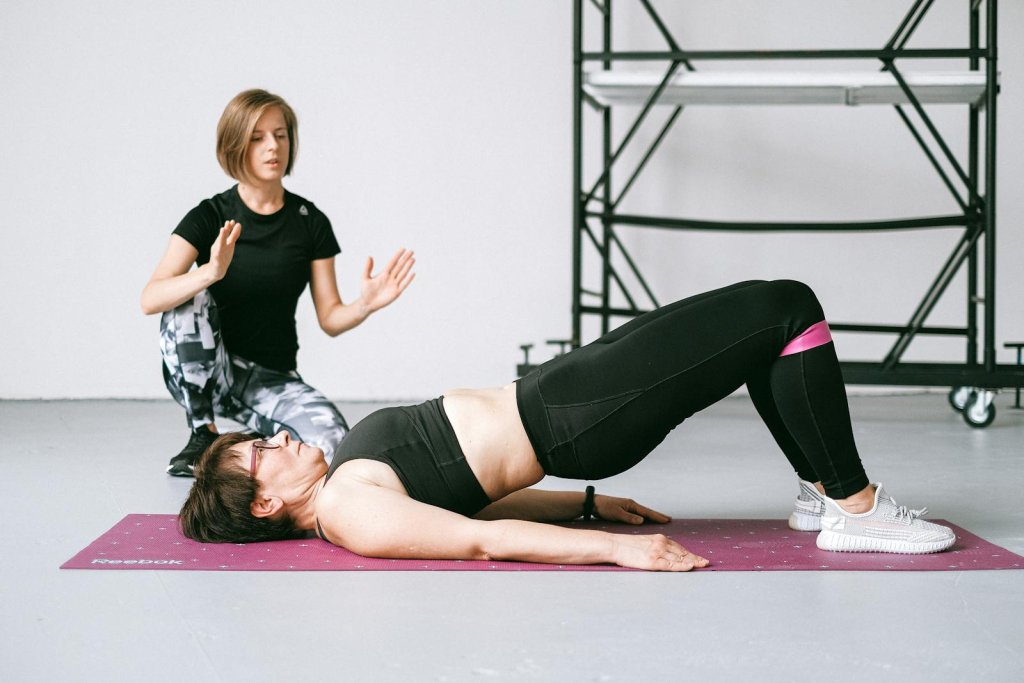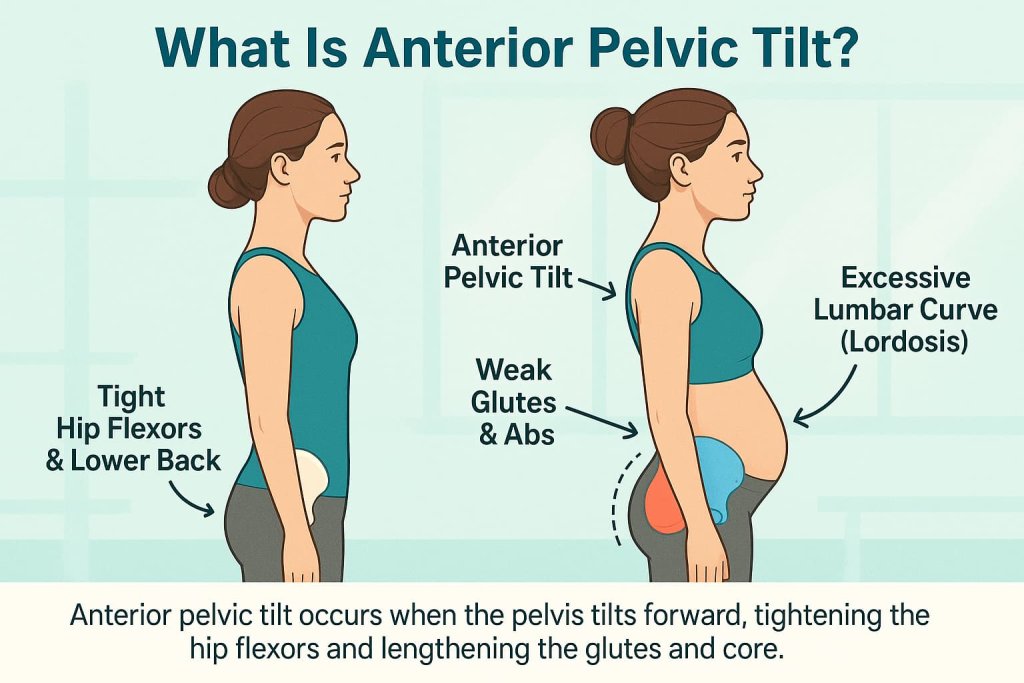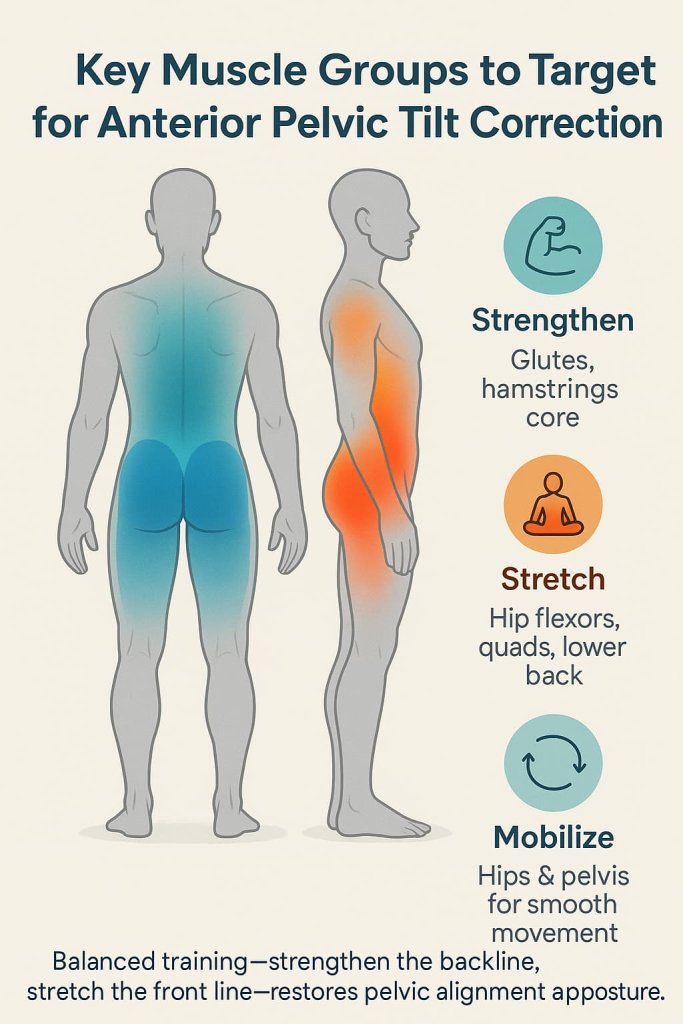If your lower back arches excessively and your hips tilt forward, you may have an anterior pelvic tilt — and the good news is, you can fix it with the right workouts.
Anterior pelvic tilt (APT) happens when your hip flexors become tight and your glutes, hamstrings, and core muscles weaken, often from long hours of sitting or poor movement habits. Correcting it matters because it improves posture, reduces back pain, and enhances athletic performance.

This guide covers the 14 best anterior pelvic tilt workouts to strengthen weak areas, release tight muscles, and restore pelvic alignment safely and effectively.
What Is Anterior Pelvic Tilt?
Anterior pelvic tilt is a postural imbalance where the pelvis tilts forward, creating an exaggerated lower back curve (lumbar lordosis). According to peer-reviewed research, anterior pelvic tilt is commonly associated with tightened hip flexors and lumbar extensors, alongside lengthened or inhibited gluteus maximus and abdominal muscles.

Common causes include:
- Prolonged sitting
- Weak core and glutes
- Tight hip flexors and quads
- Poor posture or movement patterns
Correcting it requires both stretching tight muscles and strengthening weak ones to achieve neutral alignment.
Evidence also shows that improving hip-flexor length can influence pelvic tilt and lumbar lordosis, supporting a combined approach of stretching hip flexors and strengthening glutes/abdominals.
Key Muscle Groups to Target
To fix anterior pelvic tilt effectively, focus on these areas:

- Strengthen: Glutes, hamstrings, deep core muscles, lower abs
- Stretch: Hip flexors, quadriceps, lower back
- Mobilize: Hips and pelvis for balanced movement
14 Best Anterior Pelvic Tilt Workouts
These exercises combine targeted stretches and strengthening moves to correct muscle imbalances causing anterior pelvic tilt. Perform them consistently to improve posture, relieve tightness, and restore proper hip alignment.
1. Glute Bridge
Why it works:
Strengthens the glutes and hamstrings—the key muscles that counteract tight hip flexors. This movement also improves pelvic control and helps restore neutral alignment by activating the posterior chain.
Muscles worked: Gluteus maximus, hamstrings, erector spinae, and core stabilizers.
How to do it:
- Lie flat on your back with knees bent and feet hip-width apart.
- Engage your core and drive your heels into the floor.
- Lift your hips until your body forms a straight line from shoulders to knees.
- Hold for 2–3 seconds, then lower slowly with control.
Trainer Tip: Keep ribs tucked and core tight to prevent your lower back from arching — the power should come from your glutes, not your spine.
2. Pelvic Tilt on Floor
Why it works:
This exercise re-educates your pelvic and core coordination, helping you regain control over neutral alignment and reduce excessive lumbar arching.
Muscles worked: Transverse abdominis, rectus abdominis, pelvic floor, and glutes.
How to do it:
- Lie on your back with knees bent and feet flat.
- Flatten your lower back by contracting your abs and slightly tucking your pelvis.
- Hold for 5 seconds, then relax.
- Repeat for 10–15 controlled reps.
Trainer Tip: Imagine pulling your belly button toward your spine — small, precise movement matters more than range of motion.
3. Dead Bug
Why it works:
Enhances core stability and teaches your pelvis to stay stable while your limbs move, preventing unwanted arching or tilting.
Muscles worked: Rectus abdominis, obliques, hip flexors, and transverse abdominis.
How to do it:
- Lie on your back with arms extended and legs bent at 90°.
- Lower one arm and the opposite leg toward the floor while keeping your back flat.
- Return to the start and switch sides.
Trainer Tip: Keep your ribs pulled down and avoid letting your lower back lift — control each rep with your breath.
4. Bird Dog
Why it works:
Builds spinal and hip stability while strengthening the posterior chain, essential for balancing anterior pelvic forces.
Muscles worked: Glutes, hamstrings, erector spinae, and core stabilizers.
How to do it:
- Start on all fours with hands under shoulders and knees under hips.
- Extend one arm and the opposite leg simultaneously.
- Hold for 2–3 seconds, keeping hips level.
- Return and switch sides.
Trainer Tip: Don’t overextend your leg — focus on control and symmetry, not height.
5. Hip Flexor Stretch
Why it works:
Releases tight hip flexors (psoas and rectus femoris) that pull your pelvis forward, contributing to anterior tilt.
Muscles worked: Psoas major, iliacus, quadriceps.
How to do it:
- Kneel on one knee with the other foot forward.
- Slightly tuck your pelvis and gently shift forward until you feel a stretch in the front of your hip.
- Hold for 30–45 seconds per side.
Trainer Tip: Keep your torso upright — avoid leaning forward or arching your back.
6. Plank
Why it works:
Engages your core and glutes to stabilize the pelvis and spine in neutral alignment.
Muscles worked: Rectus abdominis, obliques, glutes, shoulders, and transverse abdominis.
How to do it:
- Lie face down, supporting your weight on elbows and toes.
- Form a straight line from head to heels.
- Engage your abs and glutes, holding for 30–60 seconds.
Trainer Tip: Squeeze your glutes slightly — this posterior tilt helps correct excessive lumbar arch.
7. Side Plank
Why it works:
Targets the obliques and stabilizers that keep your pelvis level and prevent lateral tilt or rotation.
Muscles worked: Obliques, transverse abdominis, glute medius, shoulder stabilizers.
How to do it:
- Lie on your side, supporting your body on one forearm.
- Lift your hips to create a straight line from head to feet.
- Hold for 20–40 seconds per side.
Trainer Tip: Keep your hips stacked — don’t let them sag or twist forward.
8. Romanian Deadlift (Bodyweight or Dumbbell)
Why it works:
Strengthens the hamstrings and glutes, which counteract anterior tilt and stabilize the posterior chain.
Muscles worked: Hamstrings, gluteus maximus, erector spinae, and adductors.
How to do it:
- Stand tall with a soft bend in the knees.
- Hinge at your hips, keeping your spine straight and chest lifted.
- Lower until you feel tension in the hamstrings.
- Drive through your heels to return upright.
Trainer Tip: Keep the movement slow — this isn’t a squat; it’s a hip hinge.
9. Cat-Cow Stretch
Why it works:
Improves spinal mobility and enhances awareness of your pelvic position through dynamic movement.
Muscles worked: Erector spinae, abdominals, and hip flexors.
How to do it:
- Begin on hands and knees.
- Inhale, arch your back and lift your head (Cow).
- Exhale, round your spine and tuck your pelvis (Cat).
- Move fluidly for 8–10 cycles.
Trainer Tip: Focus on initiating each motion from your pelvis, not your shoulders.
10. Kneeling Glute Stretch
Why it works:
Releases tight quads and hip flexors, improving pelvic mobility and reducing anterior tilt.
Muscles worked: Quadriceps, hip flexors, glutes.
How to do it:
- From a kneeling lunge position, grab the back foot and gently pull it toward your glutes.
- Keep chest upright and pelvis tucked.
- Hold for 30 seconds each side.
Trainer Tip: Avoid arching your back — you should feel the stretch in the front of your hip and thigh.
11. Core Marches
Why it works:
Activates deep core muscles to stabilize your pelvis during leg movement — great for beginners managing tilt.
Muscles worked: Transverse abdominis, rectus abdominis, and hip flexors.
How to do it:
- Lie on your back with knees bent 90°.
- Lower one foot toward the floor, keeping your back flat.
- Alternate sides slowly for 12–15 reps.
Trainer Tip: Exhale as you lower each leg — this helps maintain core tension and spinal stability.
12. Standing Hip Extensions (Band or Cable)
Why it works:
Targets glute activation while opening tight hip flexors, key for rebalancing pelvic alignment.
Muscles worked: Gluteus maximus, hamstrings, core stabilizers.
How to do it:
- Attach a resistance band behind you at ankle level.
- Stand tall and extend one leg straight back.
- Squeeze your glute at full extension and return slowly.
- Perform 12–15 reps per side.
Trainer Tip: Keep your torso upright — don’t swing the leg; control each movement.
13. Seated Hamstring Stretch
Why it works:
Improves hamstring flexibility, promoting better pelvic control and reducing tension in the posterior chain.
Muscles worked: Hamstrings, calves, and lower back.
How to do it:
- Sit tall with legs extended in front.
- Hinge forward from hips, keeping your back straight.
- Hold for 30 seconds, repeat twice.
Trainer Tip: Focus on elongating the spine — don’t round your back to reach further.
14. Wall Angels
Why it works:
Opens chest and shoulders, promoting proper upper-body alignment to complement pelvic correction.
Muscles worked: Rhomboids, rear deltoids, traps, and core stabilizers.
How to do it:
- Stand with your back flat against a wall, arms bent 90°.
- Slowly slide your arms up and down the wall while keeping contact.
- Perform 10–15 slow reps.
Trainer Tip: Keep your ribs and lower back against the wall — if they lift, reduce your range of motion.
How Often Should You Do These Workouts?
For best results:
- Frequency: 3–4 times per week
- Sets/Reps: 2–3 sets of 10–15 reps per exercise
- Progression: Focus on slow, controlled movement before adding weight
- Tip: Combine strengthening with daily posture awareness — avoid sitting for long periods without standing or stretching.
Benefits of Fixing Anterior Pelvic Tilt
- Reduces lower back and hip discomfort
- Improves posture and appearance
- Increases core strength and stability
- Enhances performance in lifting, running, and daily movement
Frequently Asked Questions (FAQ)
1. How long does it take to fix anterior pelvic tilt?
With consistent training (3–4 times per week), noticeable improvement may appear in 4–8 weeks, depending on severity.
2. Can sitting all day cause anterior pelvic tilt?
Yes. Prolonged sitting tightens hip flexors and weakens glutes and abs, increasing pelvic forward tilt.
3. Should I stretch or strengthen first?
Start with gentle stretching of tight areas (hip flexors, quads), then strengthen weak muscles (glutes, hamstrings, abs).
4. Can anterior pelvic tilt cause back pain?
Yes — excessive tilt can strain lower-back muscles and joints, leading to discomfort.
5. Do I need equipment?
Most exercises are bodyweight-friendly. Resistance bands or light dumbbells can enhance results.
6. Can posture correctors help?
They may provide short-term support but won’t fix the underlying muscle imbalance — consistent exercise is key.
7. Is anterior pelvic tilt permanent?
No. With targeted workouts and posture awareness, most people can restore near-neutral pelvic alignment.
Conclusion
Fixing anterior pelvic tilt isn’t about quick fixes — it’s about consistency, strength, and mobility balance. By performing these 14 workouts regularly, you’ll restore posture, relieve tightness, and move more freely in everyday life.
Start today — strengthen your core, activate your glutes, and take control of your alignment.
This content is for informational purposes only and not medical advice.
References
- BMC Musculoskeletal Disorders (2024) — Posterior Pelvic Tilt Stretch vs Conventional Hip Extension Stretch
https://bmcmusculoskeletdisord.biomedcentral.com/articles/10.1186/s12891-024-07988-9 - Konrad et al., 2021 (PMC) — Influence of Hip Flexor Stretching on Performance
https://pmc.ncbi.nlm.nih.gov/articles/PMC7922112/ - Tsartsapakis et al., 2024 (PMC) — Core Stability Exercises & Muscle Thickness
https://pmc.ncbi.nlm.nih.gov/articles/PMC11036226/ - MDPI Sports (2023) — EMG/Stabilometric Analysis of the Bird Dog
https://www.mdpi.com/2075-4663/11/6/119 - JOSPT — Kinesiology of the Hip: Muscular Actions (Neumann)
https://www.jospt.org/doi/10.2519/jospt.2010.3025 - Phys Ther Rehabil (2018, PMC) — McGill Stabilization vs Conventional Physiotherapy for Low Back Pain
https://pmc.ncbi.nlm.nih.gov/articles/PMC5908986/
